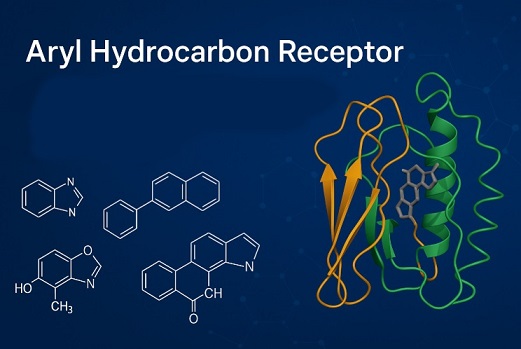Aryl Hydrocarbon Receptors Help RNA Viruses Including SARS-CoV-2 and HIV Evade the Immune System
Nikhil Prasad Fact checked by:Thailand Medical News Team May 03, 2025 6 months, 1 week, 13 hours, 45 minutes ago
Medical News: Scientists Reveal a Shocking Immune Saboteur Inside the Human Body
In a major scientific breakthrough, researchers from the Department of Cell Biology and Genetics and the Czech Advanced Technology and Research Institute (CATRIN) at Palacký University Olomouc in the Czech Republic have uncovered how a little-known molecule in our body, called the aryl hydrocarbon receptor (AhR), plays a dangerous double role during RNA virus infections—including COVID-19, influenza, HIV, Zika, dengue, and hepatitis C.
 Aryl Hydrocarbon Receptors Help RNA Viruses Including SARS-CoV-2 and HIV Evade the Immune System
Aryl Hydrocarbon Receptors Help RNA Viruses Including SARS-CoV-2 and HIV Evade the Immune System
AhR is a molecule naturally present in many immune cells and was originally known for its role in detecting harmful environmental chemicals like dioxins and pollutants. But this
Medical News report reveals that many viruses have figured out how to manipulate AhR to sabotage the body’s defenses, multiply more easily, and worsen disease outcomes.
A Cell Molecule That Turns Against Us
AhR is activated by a wide range of compounds, from pollutants in cigarette smoke to natural chemicals in food like broccoli or green tea. It is also activated by substances produced in our own bodies during inflammation or infection. When triggered, AhR moves into the cell’s nucleus and changes how certain genes are expressed. Normally, this helps with detoxifying chemicals. But viruses hijack this process to escape the immune response.
The study explains how RNA viruses—including SARS-CoV-2 (which causes COVID-19), influenza, HIV, and Zika—exploit AhR activation to block critical immune responses like type I interferon production. For example, SARS-CoV-2 infection activates AhR, which in turn reduces interferon levels, increases ACE2 receptors (which the virus uses to enter cells), and boosts mucus production in the lungs—leading to severe respiratory problems and low oxygen levels. Blocking AhR with specific drugs significantly lowered viral load in lab and animal models.
Flu Viruses and AhR Manipulation
In the case of influenza, AhR activation impairs the body’s T cell responses and increases damaging inflammation in the lungs. The study found that exposure to AhR-activating chemicals, especially during early life, reduces the body’s ability to fight off the flu and increases disease severity. This is likely due to permanent changes in DNA methylation patterns of immune cells.
HIV and the Dual Role of AhR
With HIV, AhR seems to have two faces. On one hand, it helps reactivate the virus from its dormant state, increasing viral replication. On the other hand, when activated by certain natural compounds like FICZ, AhR suppresses HIV by blocking essential viral processes inside T cells and macrophages. These findings suggest that AhR-targeted treatments might help control or even eliminate HIV in combination with other therapies.
Aiding Viral Spread i
n Zika and Dengue
The research also found that AhR is essential for replication of the Zika virus in both liver and brain cells, which may explain why Zika causes severe neurological damage in unborn babies. In mice, blocking AhR reduced symptoms and viral load. Similarly, all four types of dengue virus were found to replicate more efficiently when AhR was activated in lung cells.
Link to Liver Damage in Hepatitis C
AhR plays a key role in helping hepatitis C virus hijack lipid metabolism in liver cells. By boosting the formation of lipid droplets used by the virus for replication, AhR indirectly increases the production of infectious viral particles. This could also contribute to liver cancer development in long-term HCV infections.
Could Targeting AhR Be a Game Changer
The researchers suggest that inhibiting AhR could become a powerful new way to treat viral infections. In lab studies and animal trials, AhR inhibitors like CH223191 have already shown promise in reducing viral replication and improving survival. Some of these drugs are already being tested in cancer trials, which could accelerate their use for infectious diseases.
Another potential strategy lies in diet. Since many natural foods contain compounds that influence AhR activity, nutrition might one day be used to fine-tune this immune modulator and strengthen our resistance to viruses.
Conclusion
This study opens a new window into how our own body’s molecular pathways can be twisted by viruses for their benefit. The aryl hydrocarbon receptor, once known mainly for detoxifying pollutants, is now revealed to be a central player in the outcome of several deadly infections. By manipulating AhR, RNA viruses can suppress immunity, increase inflammation, and enhance their own survival. Targeting AhR offers a promising new avenue for antiviral treatments, but more clinical research is needed. Future therapies may involve a combination of AhR blockers, traditional antivirals, and even nutritional interventions to outsmart viral pathogens and restore immune balance.
The study findings were published in the peer reviewed journal: Critical Reviews in Microbiology.
https://www.tandfonline.com/doi/full/10.1080/1040841X.2025.2497789
For the latest on Immunology, keep on logging to Thailand
Medical News.
Read Also:
https://www.thailandmedical.news/news/aryl-hydrocarbon-receptor-identified-as-a-proviral-host-factor-for-sars-cov-2-replication-and-can-used-as-a-therapeutic-target-against-all-variants
https://www.thailandmedical.news/news/covid-19-news-hp163-identified-as-inhibitor-of-host-factor-aryl-hydrocarbon-receptor-ahr-that-aids-viral-replication-in-zika-and-possibly-covid-19
https://www.thailandmedical.news/news/newly-discovered-mysterious-human-gene-vilmir-found-to-be-activated-by-flu-covid-19-and-rsv-infections
https://www.thailandmedical.news/articles/immunology
https://www.thailandmedical.news/pages/thailand_doctors_listings
